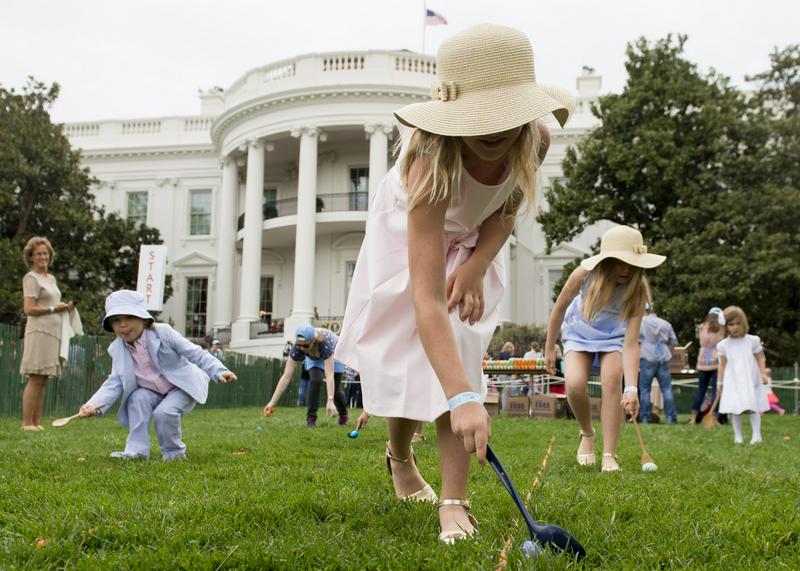The White House Easter Egg Roll: A Tradition Like No Other
By | April 16, 2019

One of the oldest and most whimsical of all the White House traditions is the annual Easter Egg Roll, an event that is held on the South Lawn of the White House and is hosted by the First Lady. Celebrated on Easter Monday, the event attracts a bevy of adorable children, dressed in their Easter finest, all rolling brightly-colored eggs along the perfectly-manicured lawn. Let’s take a look at this charming, long-running holiday tradition.

What’s an Easter Egg Roll?
An Easter Egg Roll is a fun, friendly race in which children roll a colored egg through the grass with a long-handled spoon. The tradition of rolling Easter eggs seems to be the result of a merger of pagan and Christian springtime rituals. In pagan beliefs, the egg often symbolized fertility and the rebirth of Spring. Many pagan symbols were later adopted into Christianity, including the egg. Rolling an Easter egg morphed into a Christian practice that symbolized rolling the rock away from the tomb of Jesus before the resurrection.

A Long Tradition
The tradition of celebrating Easter Monday by rolling eggs at the White House started as a private event for the President of the United States and his family. By all accounts, it was the gregarious First Lady, Dolley Madison who first proposed that the event be open to the public in 1814 and held on the grounds of the Capitol Building. That would be totally in character for the social butterfly, Dolley Madison, but it may not be entirely accurate. There have been stories of informal egg roll parties on the White House and Capitol grounds dating back even earlier. It has even been claimed that Abe Lincoln’s children rolled their own eggs on the White House lawn.

The First Official Egg Roll
The children of President Rutherford B. Hayes and his wife, Lucy, requested an Easter Egg roll on the White House lawn. A new lawn had been installed on the grounds of the Capitol Building and the landscapers would no longer allow children to play with their Easter eggs there. So President Hayes hosted the first official White House Easter Egg Roll on April 22, 1878, an Easter Monday. With a few notable exceptions, the Easter Egg Roll has been held every year since.

The Easter Egg Roll and World War I
President Woodrow Wilson and First Lady Edith Wilson presided over the White House Easter Egg Roll on April 24, 1916, not know that it would be the last time before the event had a five-year hiatus. The press delighted in an appearance by the President’s granddaughter, eleven-month old Ellen Wilson McAdoo, daughter of Eleanor and William Gibbs McAdoo, the Secretary of the Treasury. But even the appearance of Baby McAdoo couldn’t lift the solemn war-time mood. The next year, in 1917, the Easter Egg Roll was moved to the grounds of the Washington Monument. After that, it was canceled entirely for four years due to the wartime food rationing.

The Grand Return of the Egg Roll
The White House Easter Egg Roll tradition returned in 1921 with a bigger and better celebration. Under the direction of President Warren G. Harding and his wife, First Lady Florence Harding, the event featured a concert by the Marine Corp Band, the children’s play Alice and the White Rabbit, and a special appearance by the presidential dog, Laddie Boy, an Airedale terrier. The event was designed to show the resiliency of the American people and the return to normalcy after World War I.

A Long Run of Cancellations
The annual Easter event was canceled again in 1943, 1944, and 1945 due to World War II. Just as it seemed like the eggs might roll again at the White House, the event was canceled again. It was with a sad and reluctant heart that President Harry S. Truman canceled the annual Easter Egg roll in 1946 and 1947. Food conservation efforts were in full force and it was foolish and wasteful to destroy so many eggs that could be used as food. The egg roll was again postponed between 1948 and 1952 because of restoration work being done at the White House.

A Triumphant Return
After so many years in hiatus, the White House Easter Egg Roll tradition was resurrected on April 6, 1953. Since then, the event has grown bigger and bigger and experienced several notable firsts. In 1954, First Lady Mamie Eisenhower insisted that the event be open to African-American children for the first time in its history. When First Lady Pat Nixon hosted the event in 1969, a White House staffer donned a white jumpsuit and Peter Rabbit mask to greet children. Since then, a costumed Easter Bunny has been in attendance at the Egg Roll. In 1998, the White House Easter Egg Roll was broadcast live on TV and it was live streamed on the internet for the first time starting in 2009.

What to Expect at This Year’s White House Easter Egg Roll
This year’s White House Easter Egg Roll will be held on Monday, April 22 and hosted by First Lady Melania Trump. Tickets for the event were already awarded via an online lottery and participating children will receive a commemorative wooden Easter Egg in a bright color to help them remember the day they took part in a 141-year old tradition.

